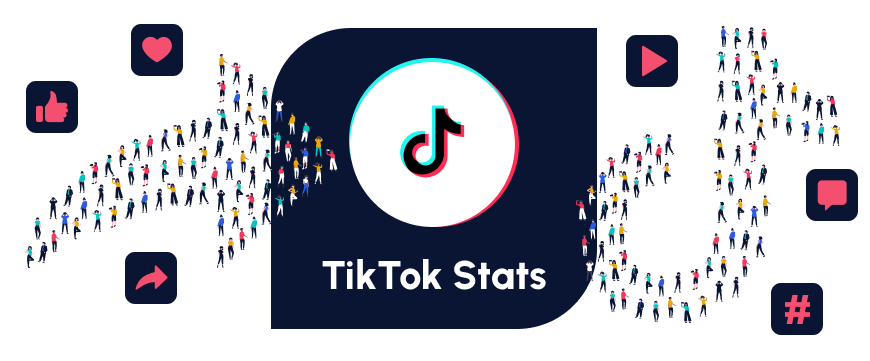
These past few years, TikTok has become an undeniable part of our lives. It’s where we create short videos, share them, follow others, laugh, dance, and express ourselves. But TikTok didn’t even exist until 2017. And before then, many other short video apps had risen, including Likee and WeChat, and fallen, like Vine.
What makes TikTok so special is that you can be as creative or silly as you want on TikTok — and you can do it with over one billion other people! So how did TikTok grow from a small app into one of the most influential social media platforms in the world? And how did those changes affect its influence? We’ll answer these questions with the help of our thoroughly researched data on TikTok.
TikTok: General Stats
Who Invented TikTok?
Zhang Yiming, the owner of ByteDance, a tech giant based in China, released the Chinese version of TikTok called “Douyin” in September 2016. This happened seven years after the Chinese government banned leading social networking sites like Facebook and Instagram. And yet Zhang’s app appealed to the Chinese more than its predecessors.
Before its global release, Douyin amassed 100+ million users and became the second most downloaded app in the Chinese Apple Store. Seeing how more people were attracted to Douyin, ByteDance acquired Musical.ly, a video-based software that targeted a teen audience.
Users of Musical.ly called themselves Musers and could use in-app features like filters and audio from songs and movie clips to record lip-sync videos that were no longer than 15 seconds. Despite its exciting features, Musical.ly had suffered from poor planning and financial mishaps, so ByteDance shut it down in 2017. That same year, ByteDance created TikTok.
Despite both apps being developed by the same parent company, they serve different audiences and have slightly different features. For example, while TikTok is used in over 150 countries worldwide, Douyin can only be downloaded and used in China. Also, TikTok has 1+ billion monthly active users, while Douyin has just about 780 million monthly active users.
Total Downloads (Worldwide)
TikTok bagged the first position among social media apps in terms of Google Play and App Store downloads in 2022. Instagram comes second, followed by WhatsApp, then CapCut, but YouTube sits pretty low on the list — it’s not even among the top 10!
Here’s the full list:
- TikTok: 672 million
- Instagram: 548 million
- WhatsApp: 424 million
- CapCut: 357 million
- Snapchat: 330 million
- Telegram: 310 million
- Subway Surfers: 304 million
- Facebook: 298 million
- Stumble Guys: 254 million
- Spotify: 238 million
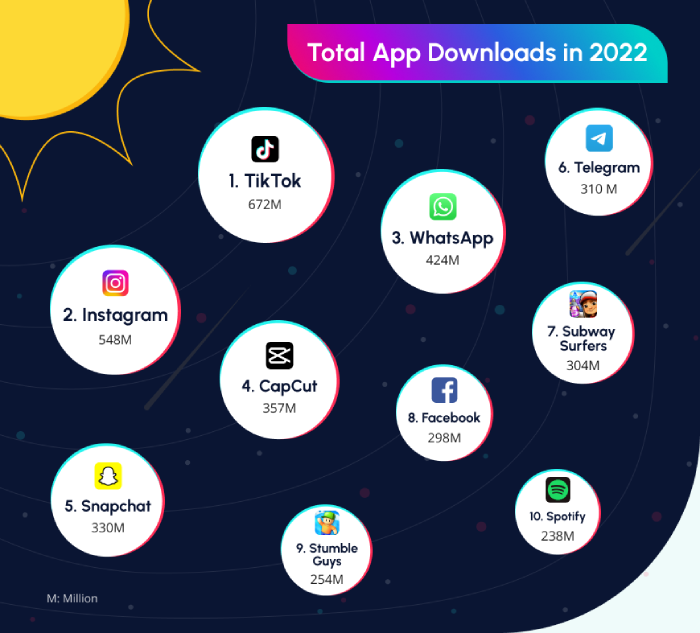
When Did TikTok Come Out in the US?
After ByteDance launched TikTok in markets outside of mainland China in 2017, the app became available to users in the United States.
Since its release, TikTok first gained ground among mobile apps in the US in early 2018 and 2019. It later rose quickly through the ranks to become the most downloaded mobile app of all time in the country.
In the US market in Q1 2022 alone TikTok has over 18 million users, surpassing the number of users on Facebook, YouTube, and HBO Max, which have 11.5 million, 11.5 million, and 11.4 million users, respectively.
When Did TikTok Become the Most Downloaded App?
You might have heard of the crazy growth TikTok has seen in recent years, but were you aware that it’s also the most downloaded app in the world?
Here’s a look at the numbers, so you have a better idea of how terrifically TikTok has been doing.
- Strikingly, at the end of its launch year (2017), the app had been downloaded 132 million times.
Fast forward to Q4 of 2018, and it had grown so much that it came in as the 4th most downloaded app across Google Play and Apple Store. However, it wasn’t until Q2 of 2020 that TikTok finally surpassed Meta apps as the most downloaded app in the world!
TikTok Downloads Year by Year
- 2016: 68 million
- 2017: 132 million
- 2018: 657 million
- 2019: 693 million
- 2020: 850 million
- 2021: 656 million
- 2022: 672 million

While TikTok might have gained a following for its lip-synching videos and dance challenges, the app’s meteoric rise to fame in 2020 was partially due to the lockdown in the wake of the COVID-19 pandemic. During that period, TikTok became another source of income for those who quit their jobs or were fired and a premium source of entertainment for everyone else who was bored.
If you look closely at these numbers, you’ll see a drop of nearly 23% in TikTok downloads in 2021. But TikTok deserves a break: this huge download dip happened because lockdown restrictions were eased.
Thankfully, data obtained at the end of 2022 shows an improvement in the number of TikTok downloads worldwide. What can we say? There’s a high chance of a further increase in TikTok downloads in 2023.
Number of TikTok Downloads on Android in Different Countries
When we rounded up the top ten countries with the highest TikTok downloads from the Google Play Store, Mexico topped the list, having over 3.075 million downloads. Other countries that made it to the top ten are:
- United States: 2.6+ million
- Nigeria: 1.8+ million
- Brazil: 1.5+ million
- Russia: 1.3+ million
- Pakistan: 1.2+ million
- United Kingdom: 868+ thousand
- Turkey: 823+ thousand
- Saudi Arabia: 823+ thousand
- Germany: 752+ thousand

What Was the First TikTok?
Back then, ByteDance had invented neither Douyin nor its sister app, TikTok, but Musical.ly was up and running just fine. When ByteDance acquired Musical.ly in 2017, it incorporated many of the app’s features into TikTok and retained Musers, who now became TikTokers.
@chshssky uploaded the first TikTok video on July 25, 2014. The video was a 12-second clip of vehicles driving along a tarred road, recorded many feet above the ground.
So technically, the first TikTok was the first Musical.ly video. For the curious ones, @chshssky now has 465.8 thousand followers on TikTok. And the video? It had 1.5 million likes — before it was deleted.
Who Has the Most Likes on TikTok?
Charli d’Amelio (@charlidamelio) has over 11 billion likes as of February 2023. This is the highest number of cumulative likes on any TikTok account.
What Is the Most Liked TikTok Video?
The most liked TikTok video is a 10-second lip-sync video uploaded by Bella Poarch on August 18, 2020. It features her bobbing her head to the lyrics of Millie B’s “M to the B,” and it has garnered over 61 million likes.
What Was the First-ever Account on TikTok?
The first account on TikTok was @douyin, which was set up by Beijing-based startup ByteDance in 2016. It is not active anymore.
How Long Did It Take TikTok to Get to 1 Billion Users?
TikTok took 5.1 years to reach 1 billion users, making it the second fastest app to achieve this milestone.
Facebook Messenger was the fastest app to reach 1 billion users. Still, its growth was accelerated by the existence of Facebook, which induced its users to download Messenger to enjoy Messenger services on their devices.
Still, TikTok beat WeChat, which took 7.1 years to reach 1B users. Across the pond, Instagram was around for 7.7 years before it reached the 1-billion-user goal, while YouTube, WhatsApp, and Facebook spent 8.1, 8.5, and 8.7 years respectively, on the journey to 1 billion users.
Billion Downloads Milestones
Thanks to it’s meteoric rise, TikTok hit the 1 billion downloads mark in Q1 2019. An amazing accomplishment in itself but it was soon surpassed! In the following year, Q1 2020 to be exact, TikTok hit another incredible milestone – it racked up more than 2 billion downloads! (this data only takes Google Play store and Apple App store).
User Base
TikTok has billions of users, and what kind of people are they? Let’s take a look.
Total Number of Active Users
On September 27, 2021, TikTok announced in its virtual newsroom that over 1 billion people visited TikTok every month to consume video content.
Two years down the line, recent statistics estimate that at least 500 million people use TikTok every month, bringing the number of MAUs to about 1.5 billion. TikTokers based in the United States make up about 80 million of this number.
Monthly Active Users (MAUs)
In 2022, TikTok ranked seventh among the world’s most popular social media apps. Snapchat came in at a close second with 750 million monthly active users, and Telegram finished last with 700+ million MAUs. Here’s the breakdown of how many users these apps had per month in 2022.
- Facebook: 2.9+ billion
- YouTube: 2.6+ billion
- WhatsApp: 2.2+ billion
- Instagram: 2+ billion
- Facebook Messenger: 1.3+ billion
- WeChat: 1.2+ billion
- TikTok: 1+ billion
- Snapchat: 750+ million
- Douyin: 730+ million
- Telegram: 700+ million
Daily Active Usage
Meanwhile, the app’s daily active usage hovered around 45.23 million in 2021. Of these 45.23 million users, 30.8 million used TikTok on iOS devices, while 14.43 million used the Android version of TikTok.
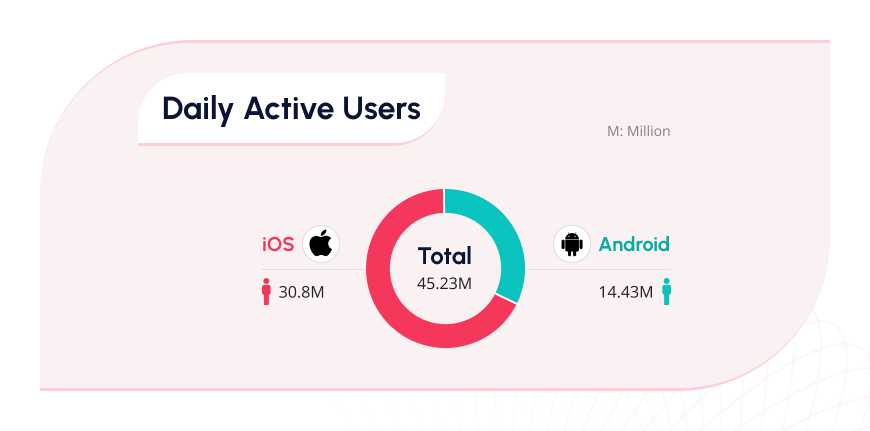
Although there is no official statistic concerning the current number of daily active users on TikTok, word on the street is that developers projected 1.05 billion DAUs worldwide at the end of Q4 2022. Why did they set such a high target? The reason is simple: to penetrate the international market.
Unlike its Chinese equivalent, Douyin, TikTok was used by less than 20% of the global population in late 2022. In comparison, Douyin penetrated over 54% of the Chinese market. You might be itching to ask, “How many people use TikTok outside China?” The answer lies in the next section.
Demographic Distribution of TikTok Users
Countries with the Most TikTok Users
TikTok makes resources, such as statistics related to advertisements, available to everyone. Sure enough, some stats reveal the much sought-after numbers of active TikTok users aged 18 years and above in selected countries. Users younger than 18 years aren’t factored into TikTok ad stats.
Consequently, the data captured below do not reflect the numbers of all active TikTok users in these countries.
- United States: 113.3 million
- Indonesia: 109.9 million
- Brazil: 82.2 million
- Mexico: 57.5 million
- Russian: 54.9 million
- Vietnam: 49.9 million
- Philippines: 43.4 million
- Thailand: 40.3 million
- Turkey: 29.9 million
- Saudi Arabia: 26.4 million
How Many TikTok Users Are in Each Region?
We know how much you love stats (and we do, too), so we scoured TikTok’s ad resources and dug up the numbers of active TikTok users in different regions worldwide. Based on our data, the total number of TikTok users aged 18 years and above in all regions is 961.8 million, Southeastern Asia has the highest number of TikTok users aged 18 years and above as of January 2023. Let’s check out the facts in detail.
- Southeastern Asia has the highest number of TikTok users, with a total of 272.2 million
- Following Southeastern Asia, Southern America has 157.8 million users and
- Northern America has 124.0 million users
Age Distribution of TikTok Users Worldwide
TikTok users are mostly 18- to 24-year-olds because that age group is the most open to exploration, creativity, and trying new things. On the other end of the spectrum, users aged 55 years and above constitute a tiny percentage of TikTokers, while those less than 18 years are at the bottom of the chain.
Here’s a lowdown on how many people across different age brackets use this short video app.
- 18 to 24: 409.1 million (38.9%)
- 25 to 34: 340.3 million (32.4%)
- 35 to 44: 164.5 million (15.6%)
- 45 to 54: 83.6 million (8%)
- ≥ 55: 53.9 million (5.1%)

Please note that the above figures are based on TikTok’s ad audience (1.051 billion users) as of January 2023.
Age Distribution of TikTok Users in the US
And here’s how the distribution looks like in the US:
- 10-19 : 32.5%
- 20-29: 29.5%
- 30-39: 16.4%
- 40-49: 13.9%
- ≥ 50: 7.1%
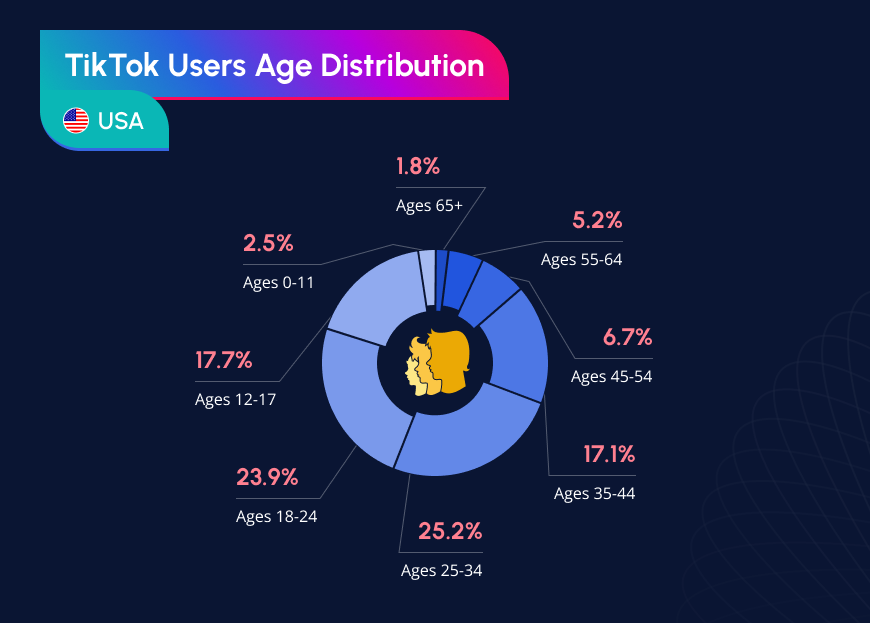
Gender Distribution of TikTok Users Worldwide
Considering there are more males than females worldwide, it’s surprising that females outnumber males on TikTok. Latest reports reveal that 54.1% of TikTokers are female and 45% are male users. Now let’s find out how many males and females are in each demographic group.
The age group with the largest TikTok users (18-24) is predominantly female: 21.5% versus 17.9% male. Similarly, females constitute 17.3% of TikTokers aged 25 to 34 years, and males make up the remaining 15.1%.
Females also top the charts in three other age groups: 35 to 44, 45 to 54, and ≥55. They make up 8.2% of TikTok users in the 35 to 44 range, 4.2% of them in the 45 to 54 range, and 2.8% of them in the ≥55 range. Meanwhile, 7.4% of Tik Tok users aged 35 to 44 years, 3.7% of Tik Tok users aged 45 to 54 years, and 2.3% of those aged 55 years or older are men.

Percentage of Returning Visitors Daily
About 29% of TikTok users visit the app every day. And what do they do when they get there? You won’t believe your ears. About 68% of these users watch someone else’s video, 63% like someone else’s video, 54% comment on someone else’s video, and 43% upload a duet video.
How Much Time TikTokers Spend on TikTok
Time is the most valuable resource. But with so many activities competing for users’ attention, why do they make time for TikTok? The reason was exposed in an official TikTok publication, which affirmed that users agreed that time spent on TikTok is well spent.
In addition, many users reported an increase in their level of happiness after visiting TikTok. To put things into perspective, about 31% of TikTokers surveyed globally said that using the app lifted their spirits. 59% of TikTok users worldwide admitted feeling a sense of community while using the app, and 84% said they found it easy to relate to TikTok content.
While giving various emotional benefits to users, TikTok affects how they consume other forms of entertainment. For example, in 2021, 35% of TikTokers spent less time watching television or other video content since they started using TikTok. 46% of TikTokers could use TikTok at a stretch without being distracted by other apps, while 45% of TikTok users spent less time on dating apps.
Weekly Time Spent on TikTok (Worldwide)
The average length of time that TikTok users spent on the app every week varied drastically. A small percentage of them used it for more than 10 hours a week, while a larger crop used it for less than 1 hour per week. Here’s the full story, told in numbers:
- 30% of users: < 1 hour
- 19% of users: 1 hour
- 19% of users: 1-2 hours
- 15% of users: 2-5 hours
- 11% of users: 5-10 hours
- 6% of users: 10+ hours

Daily Time Spent on TikTok (Kids and Teens)
Kids and teens are TikTok’s most loyal users. Globally speaking, they spend an average of 91 minutes on the app daily. In the US, kids and teens spend 99 minutes on TikTok daily, while UK kids and teens top the charts, spending 102 minutes on the app each day.
Daily Time Spent on TikTok (Worldwide) in 2022
TikTokers worldwide spent an average of 95 minutes per day on the platform in Q2 2022. This amount of time is higher than that spent on YouTube (74 minutes), Instagram (51 minutes), and Facebook (49 minutes). Even Snapchat was no match for TikTok, as Snapchat users spent an average of just 29 minutes on the platform per day.
Household Income of TikTok Users in the US in 2022
Using data from 2022, we found that many US TikTok users earn more than $100 000 per year. Low-income households fall at the bottom of the pack and are the fewest and farthest between. See for yourself:
- 40.2%: > $100 000
- 13.6%: $75 000 to $100 000
- 7.2%: $60 000 to $75 000
- 12.4%: $40 000 to $60 000
- 11.2%: $25 000 to $40 000
- 15.4%: <$25 000

Types of Content on TikTok
TikTok is a great platform for sharing content with friends and family. The best types of content on TikTok are entertaining and humorous videos that feature catchy music or dialogue. These could be lip-syncing to popular songs, funny skits, or comedic monologues. Additionally, videos featuring popular trends, challenges, or dance moves do well on the platform. Let’s check out these types of content in detail:
Lip Syncing: On TikTok, the most popular type of content is lip-syncing. This is when you sing along to a song and record yourself mimicking the singer’s moves and facial expressions. It’s a great way to show off your talent!
How-to Tutorials: At the core of many TikTok channels is a desire to help others. How-to videos are popular on the app, allowing creators to share their skills with followers and help them learn something new. For example, you can show your followers how to make slime or tie a bowtie.
Get Ready with Me (GRWM): TikTokers also record videos of themselves preparing to go to a particular place, e.g., school, or attend a particular event, e.g., a wedding, a red carpet event, etc. Creators often begin these videos with “Get ready with me” and show their followers sped-up versions of their preparation processes.
Dance Challenges: Dance challenges are TikTok’s bread and butter. These challenges are usually centered around a dance video with a few steps you copy, then post in response to the original challenge.
Collaboration Videos: Collaboration videos feature two or more content creators working together. Popular examples include makeup tutorials, DIY projects, and even music videos. The popularity of these videos has exploded over the last few years because they allow users to witness the talents of various creators at once.
Video Skits: Skits can be comedic or dramatic, and they may follow a script, be rehearsed and performed, or be improvised on the spot with no preparation at all. Skits are generally longer than other types of content because they rely more heavily on dialogue and visual storytelling to get their point across.
Videos Based on Trending Sounds and Hashtags: When a soundtrack or hashtag starts trending on TikTok, many creators hop in on the trend and post videos that feature those soundtracks or songs to help them go viral faster.
Most Popular TikTok Video Categories in 2023
Let’s find out what are the top TikTok hashtags in 2023:
- Comedy (1939B+): Comedic videos on TikTok are by far the most popular, which is probably because the most famous TikTokers specialize in comedy. So where does #entertainment now stand? As of 2023, it has about 54 billion views!
- Dance (550B+): #Dance retains its position in 2023, but its fame has tripled in terms of views. You can barely watch TikTok for up to 30 minutes without stumbling on a dance video. And let’s be honest; dancing isn’t even appreciated enough.
- Food (478B+): Everyone loves food. Whether it’s based on your local cuisine or a foreign dish, watching a video in this category makes your mouth water. Little wonder #food displaced #pranks from the third spot.
- Music (405B+): When you’re listening to your favorite song, your brain gets a boost of dopamine and endorphins. Your body releases feel-good chemicals that make you feel relaxed or energized. So when we found out that #music has bagged the fourth place, ditching #fitness, we understood why.
- Prank (384B+): While #prank moved down to the fifth position, it has more than four times the number of views it had three years ago. And yes, TikTokers still love pranks.
- Makeup (380B+): Did you know that makeup videos are the sixth most popular content on TikTok? And did you know that new hacks and trends are coming out daily? Well, now you do. And if you’re a makeup artist looking to get your name out there and make some money, you should consider using TikTok. In case you were wondering, #beauty now sits around 160.2 billion views, while #skincare has over 160.9 billion views.
- Movies (364B+): Covering everything from movie clips to original short films produced by TikTokers, #movie is one of the most immersive content categories on TikTok. With over 364 billion views, it effortlessly pushes #fashion down from the seventh spot.
- Fitness (287B+): So many videos have been posted in the #fitness category since 2020, bringing the total number of views for this hashtag to more than 287 billion. Conversely, recipes and cooking videos have over 202 billion views, so they don’t rank anywhere near the most popular TikTok genres of 2023.
- DIY (278B+): Like other most popular TikTok genres of 2020, #diy fell in rank. It occupies the 9th position but now has over 278 billion views, more than seven times its view count in 2020. #LifeHack and #advice, which used to hold this position in 2020, now have over 131 billion views.
- Fashion (236B+): Fashion TikToks have also had a sporadic jump in fame from 27 billion views in 2020 to more than 236 billion in 2023. This means #fashion has over 8x more views. But as other video categories also became more popular, it moved from the seventh spot in 2020 to the tenth spot in 2023. Meanwhile, #pets has grown to 86+ billion views but couldn’t make it to the top ten.
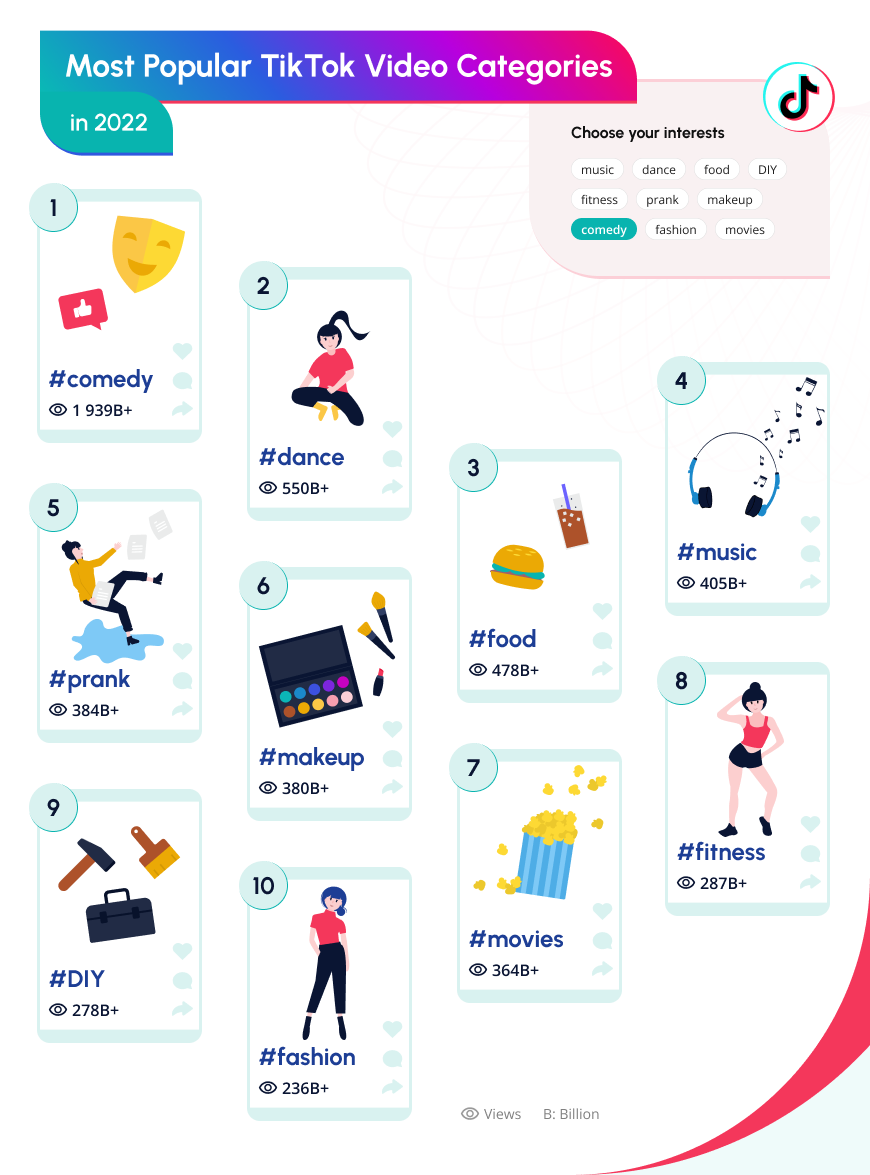
What Is the Ideal Length of TikTok Videos?
While videos shot using TikTok can be up to 60 seconds, the optimal duration lies between 10 and 15 seconds. However, you can exceed the 60-second cap by recording the video using a different app and importing it into TikTok.
Engagement Rate on TikTok in 2023
Over 140 million TikTokers are residing in the United States, but not all of them engage with TikTok. As of 2022, only 41% of these users created, liked, commented, shared, or actively participated in one activity or the other the social media app.
As we already said, the United States is home to over 140 million TikTokers, but only 41% engaged with the app in 2022. Although engagement rates were highest among users aged 18-19 at 67% and 20-29 at 56%, there is opportunity for growth with older age groups, such as the 38% of users aged 40-49 who actively participated on TikTok.
Advertising on TikTok
Although TikTok has been the biggest app for creating, sharing, and watching short videos since it launched in 2016, it wasn’t always open to advertisers.
That all changed in 2019 when TikTok launched TikTok for Business, which allowed brands to get involved with the community and reach new audiences. As of 2023, TikTok ads have click-through rates (CTR) of up to 10%, compared to the industry average of 1-2%. They also have a conversion rate of up to 4%, compared to the industry average of 1-2%.
Here’s everything you ever wanted to know about TikTok ads.
How Much Money Is Being Spent on TikTok Ads?
By the year 2021, one year after TikTok began hosting ads, it earned $4 billion in net ad revenue — $2.1 billion of which came from the United States. The $5.96 billion it made in 2022 was 1.4% higher than its earnings from 2020, and this figure equated to 1% of total digital ad spending in the US.
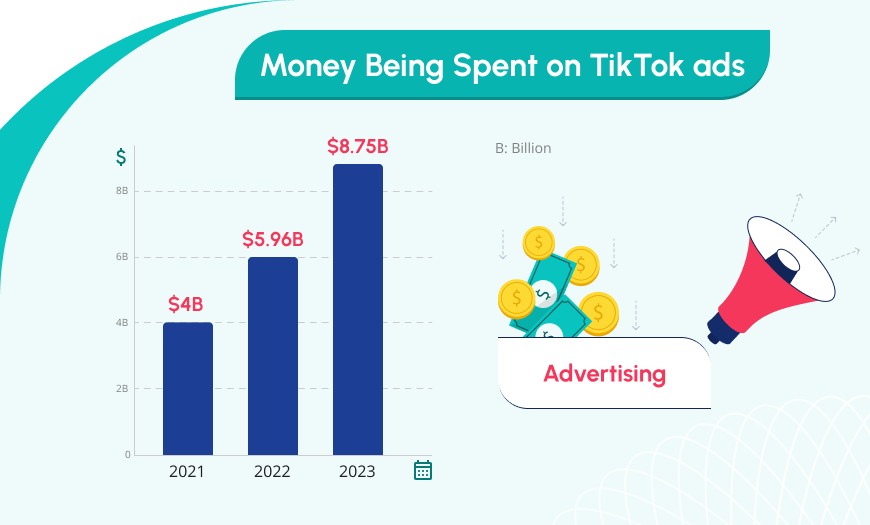
Experts at eMarketer project that by 2023, TikTok will earn $8.75 billion from running ads in America; this will make up 3.1% of national net proceeds from advertising!
Most Popular Industries Advertising on TikTok
Based on brand success stories obtained from TikTok for Business, the top ten industries using TikTok for ads in 2023 are:
- Food and beverage: 108 top brands
- Makeup and beauty: 85 top brands
- E-commerce: 72 top brands
- Clothing and accessories: 68 top brands
- Retail: 51 top brands
- Media and entertainment: 47 top brands
- Mobile apps: 39 top brands
- Financial services: top 37 brands
- Technology: 36 top brands
- Personal care: 35 top brands
As if predicting the future, Statista compiled a list of the ten brands that spent the most money on TikTok ads in 2022. They are:
- Amazon: $22.5 M
- HBO: $19 M
- Cerebral: $13.3 M
- TurboTax: $12.2 M
- HelloFresh: $11.3 M
- Samsung: $10.5 M
- McDonalds: $10.4 M
- PepsiCo: $9.7 M
- Zynga: $8.9 M
- Procter & Gamble: $8.6 M
These brands are spread across multiple industries: mobile apps (Cerebral, TurboTax, and Zynga), food and beverage (PepsiCo, McDonalds, and HelloFresh), media & entertainment (HBO), technology (Samsung) and personal care (Procter & Gamble). The top spender, Amazon, is in e-commerce.
Types of Ads Used on TikTok
In 2020, a Nielsen marketing study revealed that 43% of TikTok users felt that advertisements blended in with unsponsored content. Two years later, TikTok conducted another survey in conjunction with Lumen, using a mock TikTok feed and product placement in the videos. This survey proved that when the product being advertised was used in the ad, the ad was 23% more likable.
It turns out TikTok users don’t mind seeing ads on the app. But what types of ads are they? TikTok for Business recognizes six major types of ads: in-feed ads, TopView ads, branded hashtag challenges, spark ads, branded effects, and brand takeovers. Let’s find out how to tell them apart.
In-Feed Ads
An in-feed ad is an ad that appears in your TikTok feed. These ads should grab your attention almost immediately, within 2 to 3 seconds at most. That way you’ll be more likely to view them for longer, increasing their impact. Research by TikTok in 2021 shows that ads viewed for 6 seconds or less have 38% of the impact of those viewed for more than 6 seconds.
In addition, calls-to-action (CTAs) are super important for in-feed ads. Including a compelling CTA card, e.g., “download now,” “shop now,” or “visit website” in an in-feed ad has been proven to increase brand recall by 45% in the US. And according to a TikTok research conducted in June 2021, in-feed ads are 23% more memorable than TV ads.
TopView Ads
Topview ads on TikTok are the top-of-the-fold, full-screen ads that users see three seconds after opening the app. Like regular TikTok content, these ads play automatically. In addition, they’re no more than 60 seconds long and occupy the top spot on the user’s For You Page.
From a study of TikTok’s advertising effectiveness conducted in Russia, we found out that 76% of TikTokers correctly link topview ads with their respective brands, 78% of users play topview ads to the end and 54% of TikTokers share topview ads with others — all higher than what other digital platforms average!
Branded Hashtag Challenges
Branded hashtag challenges are contests that take place on TikTok. They’re based around an existing hashtag and offer participants the chance to win prizes, such as cash or product samples or free trips. It’s up to every brand to decide whether to create an original audio track for their branded hashtag challenge or use one of TikTok’s soundtracks. However, 78% of TikTokers in Europe agreed that ads featuring customized music lead to more track clicks!
Branded Effects
Branded effects are one of the fastest ways to improve brand awareness on TikTok. They’re special filters, 2D and 3D effects, and stickers that you can apply to your videos after they’ve been recorded. Brands create them, which means they pay TikTok a fee so that users can use them. You just record your video as usual and then apply the effect before posting it.
Spark Ads
To better appeal to TikTokers’ love of authenticity, while creating awareness for their products, TikTok launched spark ads. A spark ad is a boosted organic post that helps it get in front of more users and attracts them to your brand’s page.
In 2021, Global Web Index discovered that spark ads have a 134% higher completion rate and 157% higher 6-second view-through rate than standard in-feed ads. The company was so impressed with these results that it decided to test spark ads in 2022. After TikTok tried out the new profile landing page UI, it learned that the new design delivered a 69% higher conversion rate and 37% lower cost per acquisition than ever before.
Brand Takeovers
If you want to be the star of the show, you’ve gotta pay to play. TikTok’s brand takeovers are five-second ads that take over a user’s screen as soon as they open the app. Unlike other TikTok ads, Takeovers are exclusive, which means that only one brand can run a brand takeover in a day.
Brand Recall and Awareness on TikTok
Brand recall is the percentage of consumers who can remember a brand’s name when asked. It’s a key metric in brand marketing. On the other hand, brand awareness is the state of having a brand image in someone’s mind. It’s not what you say about your company, but also about how customers perceive your brand. So we did some research on TikTok to find out how well we’re doing with these two important measures!
Brand Recall Stats (Global)
- 62% of TikTokers worldwide can recall a brand with some help three weeks after exposure to that brand’s TikTok ad
- Featuring your logo in your TikTok ad raises your brand recall by 23%
- Exposure to a brand’s organic video content before it’s paid ad enhances brand recall by 27%
- Running an ad on TikTok before airing that same ad on television increases your brand recall for the TV ad by 4%
- TikTok ads raised brand recall for streaming ads to 53%, from 47%
- TikTok ads facilitate brand recall by 40 more percent than ad formats on other platforms
Brand Recall Stats (United States)
- 3 weeks after seeing a brand’s TikTok ad, 72% of TikTok users agree that the brand is memorable
- 3 weeks after being exposed to a TikTok ad, 76% of TikTokers trust the brand’s credibility
- Including captions in TikTok ads increases brand recall by 58%
- Using the product being advertised in the ad lifts brand recall by 25%
- Using a TikTok soundtrack in an ad makes viewers 1.2 times aware of the brand
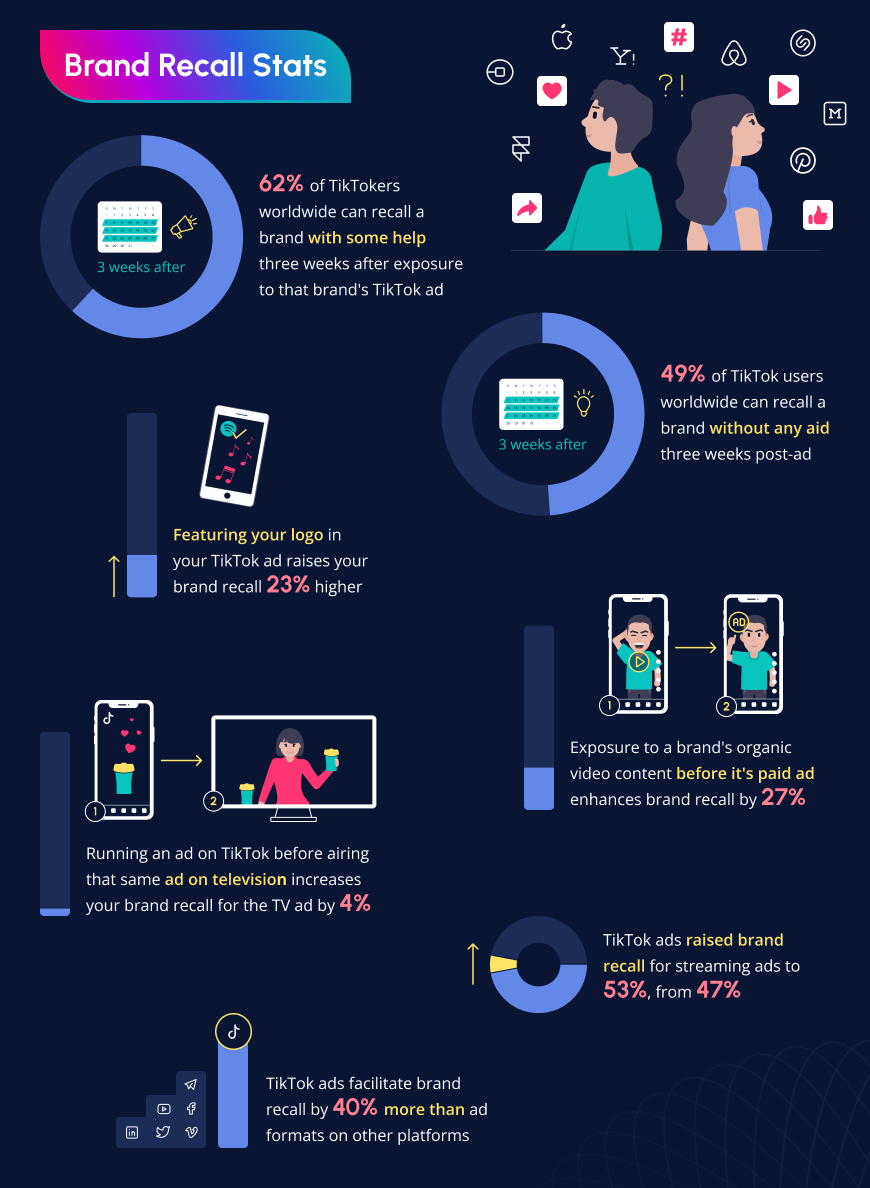
Influencer Marketing
Influencer marketing has become a big thing for brands on TikTok. Influencers are people who have built a following, and they use that following to promote products and services. For example, if you’re trying to reach 18-24 year olds who are interested in fashion and makeup, you can pay an influencer to post about your product or service. They will then reach their followers with the post, who may be interested in what you’re offering.
The idea behind influencer marketing is that you can get people to buy your product if they trust an expert’s opinion. In fact, a study by TikTok reveals that 62% of their users think the best way to advertise on TikTok is by collaborating with Creators.
Types of TikTok Influencer Campaigns
Brands have found a new way to market their products through TikTok influencers. Some of these campaigns are designed to build awareness of coming products, while others are meant to incentivize users to purchase existing products. We’ve taken a tour of TikTok, and below you’ll find several examples of each type of campaign.
Awareness-building Campaigns: These strive to make TikTokers in the brand’s target audience aware of the existence of products, services, and how to use them. Recent influencer marketing examples of this type on TikTok include:
- @nick.digiovanni for Chipotle
- #TikTokMadeMeBuyIt for L’Oreal
- @mikbrothers for Fenty Beauty
- @ohemaabonsu for e.l.f Cosmetics
- @rachelshea_ for Zara
- @chefdevan and other creators for Heinz
Product-purchase Campaigns: When using these campaigns, influencers offer users unique discount codes and encourage them to buy the goods advertised or visit the brand’s website. Some popular examples are;
- @charliedamelio for Dunkin Donuts
- @yaraaziz for Michael Kors
- @khaby.lame for Binance
- @sophie_murraayy for Fenty Beauty
- @dayanicus for NEST New York
- @lainvanogle for Ralph Lauren
Most Successful Influencers on TikTok
A lot of content creators have been making it big on TikTok, and we’re not sugarcoating things: they’re making tons of money. How big have the biggest influencers gone on the platform?
Check out our list below!
- Khabane Lame (@khaby.lame): This TikTok star has over 155 million followers on the app, about twice his follower count on Instagram. He earns an average of $400 000 per TikTok sponsorship deal and has amassed 2.4 billion likes.
- Charlie d’Amelio (@charliedamelio): She surpasses Lame in terms of like count, having 11.3 billion likes. When you consider her 150-million fanbase, and popularity, it’s easy to understand why she charges between $14 500 and $100 000 for sponsored content on her page.
- Bella Poarch (@bellapoarch): Meet the face behind the TikTok video with the most likes of all time. She has been gaining more followers since joining TikTok in 2018, and now has 92.9 million TikTok users following her page and 2.2 billion likes. And how much does she earn from TikTok? According to Exact Net Worth, Poarch receives as much as $30 000 for TikTok ads.
- Addison Rae (@addisonre): While she comes fourth in terms of follower count (88.8+ million), her content specialties are fashion and beauty. In 2020 alone, she earned about $5 million from TikTok, snatching the title of the highest paid TikTok influencer of that year.
- Zach King (@zachking): He holds the record for the most viewed TikTok video, which has 2.1 billion views. King is known for filming and posting videos edited to appear magical. As of 2023, he has over 73 million followers and 959 million likes. Online reports estimate his income from TikTok is $3 million per year.
How Many Content Creators Are on TikTok?
In 2020, according to Statista, there were 106 thousand content creators using TikTok. By 2023, search data from the Creator Marketplace show that creators are more than 160 000.
Who is the Most Followed Person on TikTok?
Social media personality Khabane Lame (@khaby.lame), who has 155 million followers and 2.4 billion likes on TikTok, unseated dancer Charli D’Amelio (@charlidamelio) for the top spot on the popular video app. D’Amelio has 150 million followers and 11.3 billion likes. Rounding out the top three spots is singer Bella Poarch (@bellapoarch) with 92.9 million followers and 2.2 billion likes.
How Does TikTok Make Money?
Behind the lip-syncing videos and live streams lies an app that’s monetized in two major ways: ads and in-app purchases.
Ads
Since 2020, businesses have been tapping into TikTok’s potential as a marketing tool. In addition to enjoying a higher engagement rate, running ads on TikTok is cheaper compared to other platforms like Facebook and Instagram. As we discussed earlier, there are six types of TikTok ads: in-feed, spark, topview, branded effects, hashtag challenges, and brand takeovers. So how much does each ad type cost?
In-Feed Ads: An effective in-feed ad costs about $0.50 per 1000 impressions, and $0.20 per click.
Spark Ads: TikTok charges around the same fee for spark ads as it does for in-feed ones.
TopView Ads: These ads are among the most powerful on TikTok, but they’re also pretty expensive. On the average, a topview ad costs $65 000 per 7.4 million impressions. This translates to about $0.87 per 1000 impressions.
Brand Takeovers: With $50 000 or more per day, you can run a brand takeover on TikTok.
Branded Effects: These cost $45 000 for 30 days.
Hashtag Challenges: They’re cheaper than brand takeovers, costing approximately $150 000 every six days.
In-app Purchases
Coins: TikTok sells coins to users at the estimated rate of $1.29 per 100 coins in the US, but prices vary by country. When users buy coins, they can use them to purchase virtual gifts for content creators and give those gifts either during live streams or through regular posts. These are the eight kinds of virtual gifts that you can buy with TikTok coins:
- Panda: 5 coins / $0.65
- Italian Hand: 5 coins / $0.65
- Love Bang: 25 coins / $0.325
- Sun Cream: 50 coins / $0.65
- Rainbow Puke: 100 coins / $1.3
- Concert: 500 coins / $6.5
- I’m Very Rich: 1000 coins / $13
- Drama Queen: 5000 coins / $65
TikTokers can purchase as many coins as they want by going to Profile > Settings > My Wallet, but can’t resell any.
Gift Commissions: Also, TikTok charges content creators a 50% commission on the value of virtual gifts they receive from their audience. To get this commission, TikTok converts gifts to diamonds, which are then deposited in the giftee’s wallet.
A diamond is worth 2 coins. So, if, for example, you buy a Rainbow Puke for $1.30 (equivalent to 100 coins) and give it to a creator, they will receive 50 diamonds, which are worth $0.65. Who gets the remaining $0.65? TikTok does.
Shop Commissions: TikTok is now home to e-shops. These shops are similar to those on other e-commerce websites and you can add any item to your cart and pay for it using Shop Pay, Gpay or Apple Pay within the app. Businesses using TikTok e-shops pay TikTok a tiny percentage of their sales as commission — around 5%.
Subscriptions: When a creator turns on the Live Subscription feature in their settings, their live streams are protected with a paywall, and only subscribers can access the chat room. In addition to live chats, subscribers receive badges and use custom-made emotes to express their feelings during the live stream.
To qualify for subscription, a TikTok channel must have at least 1000 followers and go live for at least 30 minutes. Creators on TikTok can earn a substantial amount of money from live subscriptions, but the app still takes a sizeable cut of 60%.
TikTok’s Yearly Revenue
With all the monetization strategies that TikTok adopts and how profitable they seem, you might be wondering: how much revenue does TikTok make every year? Luckily, Business of Apps collated a comprehensive report on TikTok’s earnings.
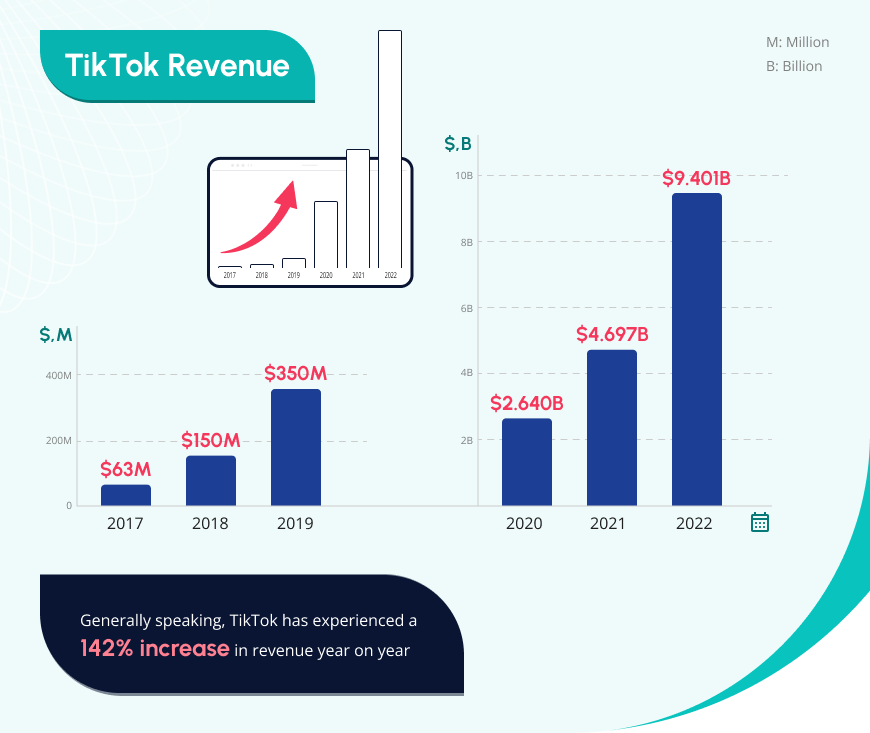
According to the report, TikTok made $63 million in 2017, $150 million in 2018, $350 million in 2019. In 2020, TikTok’s revenue jumped to $2.64 billion, perhaps due to the introduction of paid advertising. The app generated $4.697 billion in 2021 and $9.401 billion in 2022 when subscriptions were rolled out. Generally speaking, TikTok has experienced a 142% increase in revenue year on year.
What Experts Say About TikTok and Mental Health
Dr. Kat Peoples – Peoples Farm & Rabbitry Center for Education

The prevalence of Tik Tok’s short-form videos and the constant feed of content tends to overwhelm many users. Social media usage in general, not just Tik Tok, can have negative effects on mental health. I have seen it lead to a variety of negative effects such as anxiety, depression, and even suicidal thoughts. The constant scrolling on Tik Tok and exposure to a curated feed of idealized content can lead to feelings of inadequacy and a negative body image. Tik Tok has an addictive nature, and it takes people away from addressing the things they need to work on in their lives. I see it, quite often, directly creating depression, anxiety, and low self-worth in users.
It’s important for individuals to prioritize self-care and limit their screen time to maintain a healthy balance. Disconnecting from social media can be challenging, but there are a few steps that can help make the process easier. Tik Tok users should evaluate why they are using social media and determine if it is benefiting their mental health and overall well-being. If they find that social media is causing more harm than good, they should take a break or set a time limit for social media use. Additionally, it would be helpful to find alternative activities or hobbies to fill the time that was once spent scrolling through social media to create meaning and purpose in life.
Andrew Gladstone-Highland – Harvest Therapy Center
- (A) Social media provides each of us with small doses of positive self-esteem – “A lot of people liked my post!” We get little hits of positive brain chemicals when we see good feedback on social media, when we are getting the attention we have been seeking. The problem is that the process can become addictive, we can become addicted to the attention and the small,
 manufactured doses of self-esteem that we receive.
manufactured doses of self-esteem that we receive.
(B) Social media can also be a means for us to dissociate. Dissociating means that we go to a different, less alert state of consciousness – everyone dissociates when they daydream, “zone out,” or get lost in thought. The problem is that zoning out in this way can be a way to escape real life and its many complications – people avoid the problems of real life in many other ways as well, through watching TV, going online, working out all the time, or using substances. There’s nothing wrong with some amount of this kind of escape, but like anything, it can become too much.
- It’s good to set boundaries around social media use – set a timer, get off of social media an hour before you plan to go to bed, take certain apps off of your phone, so that you can only use those apps when at home. Many phones track how many hours per day you use the device, and will tell you how many hours you used each app over the course of a week – set a goal to stay under a certain threshold for the day or the week. Ask yourself, “Does being on social media make me feel better about myself, about my life?” If the answer is no, or at least not after a certain amount of usage, then try to do other things that also make you feel good about yourself and your life. Text or talk with a friend, get outside and take a walk or get some other kind of exercise, read a book, listen to music, go for a drive, watch a favorite movie. Remind yourself what you like about your life that isn’t always online.
Andrew Gladstone-Highland, LMSW
He – Him – His
Clinical Therapist and Owner, Harvest Therapy Center
Dr. Mike Bishop – Camp Pocono Trails
TikTok, like any other social media platform, has its own set of positive and negative effects. Here are some of the negative effects associated with TikTok:
- Time Consumption: TikTok is highly addictive, and users can easily spend hours scrolling through content on the app, leading to a decrease in productivity and loss of valuable time.
- Cyberbullying: Like other social media platforms, TikTok is not immune to cyberbullying. Users can use the platform to bully or harass other users, which can have a negative impact on the mental health of the victim.
- Inappropriate Content: There are concerns about the type of content that is being shared on TikTok, as some videos can contain graphic or sexual content that is not suitable for all audiences, including children.
- Negative Body Image: TikTok is known for its dance and lip-sync videos, which often feature users who are thin and conventionally attractive. This can lead to body image issues and negative self-esteem for those who do not fit that mold.
- Addiction: TikTok’s algorithm is designed to keep users engaged, and this can lead to addiction and the need to constantly check the app.
Spending too much time on screens can have negative effects on social skills in several ways. Here are a few examples:
- Reduced face-to-face interaction: When individuals spend too much time on screens, they may have fewer opportunities to engage in face-to-face interactions with others. This can make it harder for them to develop and maintain social skills, such as nonverbal communication and empathy.
- Decreased attention span: Excessive screen time can also lead to a decreased attention span, which can make it harder for individuals to focus on conversations and engage in meaningful social interactions.
- Increased social anxiety: Too much screen time can also lead to increased social anxiety, as individuals may become more comfortable interacting with others online rather than in person. This can make it harder for them to develop the confidence and skills necessary for successful face-to-face interactions.
- Limited exposure to social cues: When individuals spend too much time on screens, they may have limited exposure to social cues, such as body language and tone of voice. This can make it harder for them to interpret and respond appropriately to social cues when interacting with others.
Overall, while TikTok has its benefits, it is important to be aware of these potential negative effects and to use the app in moderation.
At the Summerland Camp program, we often recommend that parents help their kids limit screen time by first requiring their child to record their screen time in a journal. Behavioral contracts can also be helpful. As part of the the Summerland program, we help parents learn how to create a behavioral contract with their child.
Set limits: Parents can set limits on screen time by establishing clear rules about when and for how long kids can use screens. For example, they can limit screen time to a certain number of hours per day or restrict screen time during certain times of day, such as before bedtime.
Provide alternative activities: Parents can encourage kids to engage in alternative activities, such as playing outside, reading books, or participating in extracurricular activities. This can help to reduce the amount of time kids spend on screens and promote healthy habits.
Lead by example: Parents can model healthy screen habits by limiting their own screen time and engaging in alternative activities with their kids. This can help to reinforce the importance of balance and healthy habits.
Use parental controls: Many devices and apps have parental controls that allow parents to restrict access to certain apps or limit screen time. Parents can use these controls to help enforce their screen time rules and limit access to screens.
Create screen-free zones: Parents can establish certain areas of the house as screen-free zones, such as the dinner table or bedrooms. This can help to promote face-to-face interaction and limit the amount of time kids spend on screens.
Jerimee Smith – Embrace Change Counseling
1.) The negative effects of TikTok are the same as most social media and instant electronic media engagement in which it engages the instant gratification, dopamine release in the brain. This then can become an issue in which we crave and desire instant gratification to the exclusion of other activities which are more delayed gratification. Delayed gratification activities are normally healthy things such as completing tasks that move you toward accomplishing goals. If the behavior becomes harmful to other areas of life such as relationships, work performance, or impedes succeeding toward goals then this may be considered an addictive behavior.
2.) For those spending too much time on it to the exclusion of productive activities, what can be helpful is taking prescribed breaks and during these breaks engage in mindfulness, mindful meditation, and overall activities in which you can be present in the moment without engaging in social media such as TikTok. Examples of being present in the moment may be exercise, engaging in a conversation, or otherwise working to be mindfully present in the moment. Therapy can be useful and helpful in the event you find it difficult to engage in breaks from social media as therapy can provide an atmosphere of support and accountability.
Lysandra Penn-Bartoo – Bloom Counseling
- What are the (negative) effects of Tiktok/Social Media?
Although there are some positive effects of using social media, such as receiving validation, finding others with similar interests worldwide, and allowing us insight into each others’ lives, there are also some adverse effects to be cognizant of, specifically regarding brain development and mental health. Since my clientele is primarily females aged 15-22, my observations focus on this gender and this age group.
When I ask my clients how they feel social media affects them, the most frequent response revolves around comparison mindsets, often concerning their appearance. Social media platforms tend to promote unrealistic beauty standards, leading to feelings of inadequacy. Teenage girls report feeling pressure to conform to these standards, leading to negative self-image and low self-esteem.
These comparison mindsets tend to flourish from the specific insecurity a client may have—a client concerned about their success might insert comments about a TikToker’s success in a session. Clients who are artistic and spend a lot of time doing art report feeling discouraged due to seeing all the other fantastic art being shared online, even though someone else’s skills do not decrease their own. These are also the more obvious examples I get to see. I know social media’s effects can be a lot more insidious, and my clients may not always be aware of how social media affects them, just like none of us are entirely due to so much of our thought process being unconscious.
In a more frightening scenario, I have heard some specific instances from clients of mine where they were introduced to TikTok communities that glorify eating disorders or self-harm.
A recent article in the New York Times (2022) revealed how quickly the algorithm can show problematic content to young viewers. This experiment was done by asking eight researchers to create a TikTok account, all posing as 13-year-olds. Within 30 minutes and sometimes as little as 3 minutes, the researchers saw videos promoting harmful content through pretty innocuous pathways. Then it snowballs as the algorithm keeps showing the content being interacted with and lingered on. These findings support what I have observed in psychotherapy sessions.
I want to note that I’m aware TikTok has interventions in place to remove these videos.
There are also understandable concerns about the addictive nature of social media and how it is intentional in its design. Dopamine is a neurotransmitter that plays a critical role in the brain’s reward and pleasure systems, and the use of social media platforms like TikTok can trigger the release of dopamine in the brain. The constant stimulation and novelty on TikTok may lead to a “dopamine loop,” where users feel compelled to keep scrolling and watching videos to continue experiencing the pleasurable effects of dopamine. This loop can lead to excessive use of TikTok and potentially harmful effects, particularly in young and developing brains.
This addictive nature of social media compounds, meaning people spend more time on social media, which turns into staying up later at night. They are also experiencing melatonin suppression from the blue light emitting from their phone, which makes it harder for them to fall and stay asleep. Lack of sleep exacerbates anxiety and depression symptoms by affecting multiple processes in our brain, such as our amygdala and neurotransmitters. The amygdala is a part of the brain that plays a crucial role in processing emotions, particularly fear and anxiety. There is a well-established link between sleep and the amygdala, as rest can significantly impact the functioning of this brain region. Additionally, a lack of sleep can also affect the levels of neurotransmitters in the brain, including serotonin and dopamine, which play a crucial role in regulating mood. Getting enough good-quality sleep is therefore essential for maintaining emotional well-being.
- What can we do to help people who are maybe spending a little too much time on it?
Dialectical Behavior therapy encompasses a lot of themes that prove helpful in creating awareness regarding our usage of social media. Here are a few techniques that might be helpful in reducing your usage and dependency on social media:
Mindfulness: DBT emphasizes the importance of being present in the moment. Practice being mindful while using social media by paying attention to your thoughts, feelings, and physical sensations. Notice what arises for you as you are consuming social media content. Do you notice a tightness in your chest or a sensation of your stomach dropping? These can often be physical cues of anxiety. This awareness can help you become more mindful of how much time you spend on social media and how it affects you.
Self-soothing: When you feel the urge to check your phone or social media accounts, try self-soothing instead. This activity can be anything that helps you feel calm and relaxed, such as taking a walk, listening to music, or practicing deep breathing. Often the urge to use social media may come from boredom, loneliness, or other painful feelings.
Radical acceptance: Accept that social media is a part of our modern world and that it can be challenging to avoid it altogether. Instead of fighting against it, try to find a balance that works for you. Set specific times of the day to check your accounts, and stick to them.
Distract yourself: When you feel tempted to check your phone, distract yourself with something else. Engage in an activity that requires your full attention, such as a puzzle or a book. If you would like to still be on your phone, consider spending time on an app that doesn’t elicit negative feelings. Apps like Duolingo can be a fun way to spend time on your phone while learning a language.
Lastly, creating a barrier like putting the social media app off your main screen, even in a different folder on a screen that isn’t the main one, can make it harder for you to access it, even if it takes only a few extra seconds to open the app. Any barriers can help prevent mindlessly opening and scrolling on the app. The ultimate intention would be to change mindless scrolling to mindful scrolling.
It’s essential to be patient and kind to yourself as you work to develop a healthier relationship with social media. We have built these patterns around social media over many years, so it is natural that these patterns can’t be unraveled overnight. The design of apps like Tiktok is also created to make it hard to exit the app and to continuously spark a dopamine loop. Being compassionate to yourself and looking inward at the effects you may experience can help you have a more balanced and healthful perspective on social media and your specific usage.
Maegdlyn Morris – The Counseling Source Inc.
There are overwhelmingly negative side effects of social media, here are some.
ADhD is an exploding diagnosis among young adults. This has occurred concurrently with the advent of short brief blips that people have become addicted to. If a developing brain is trained by 1.5 minute blips of data then of course they are going to have attention span problems. Further, online addiction has replaced being out in nature, playing in the physical world with other people, and engaging face to face. All of this contributes to what looks like ADHD symptoms and the only successful treatment for this is to get off of the internet and engage in the physical world where ones attention span can be stimulated in longer segments.
Another major problem is the development of identity in adolescents. When one is growing up and comparing oneself to an image on the internet that has been artificially altered , it is an unwinnable game. Online bullying is also rampant, and can be magnified by the thousands.
Eating disorders are being marketed by tik tokkers, an Ohio boy just died after taking a tik tok benadryl challenge.
Online predators have proliferated due to the lack of regulation on checking the age of individuals. My family is tight knit, well educated and spends a lot of time with their children. One of my highly intelligent neices, was able to market herself and became hyper sexualised by finding material on the internet. By the time we took her phone, she was sneaking out to meet adult men at the age of 13.
You tube for children is being marketed as safe for young kids. First of all there is no safe amount of time on the internet for young children due to the concepts I mentioned earlier with respect to attention. Second of all, within four clicks a five year old can begin to be exposed to innapropriate content that can amount to sexual grooming.
How can we help?
This is the million dollar question. In my experience I have treated this as if the client was a member of a cult. I dont try to dissuade them from their usage, rather I instead encourage exposure to nature, limiting overall time on the internet, and sending them towards more healthy outlets such as ted talks and curiosity channel. I also encourage them to consider meet up if they are adults, in order to begin finding human connection again. Loneliness is becoming another tragic side effect, most adults have replaced much of their socializing with online access.
Conclusion
TikTok has developed into a phenomenon that shows no signs of slowing down anytime soon. As long as the app can keep growing its user base and adding features to enhance the user experience, it will continue to be a powerhouse in the social media industry. Almost overnight, TikTok rose up to be one of the most popular apps in the world — it looks like it’s here to stay. Now go forth, bold and hopefully well-prepared soul, and conquer TikTok!

